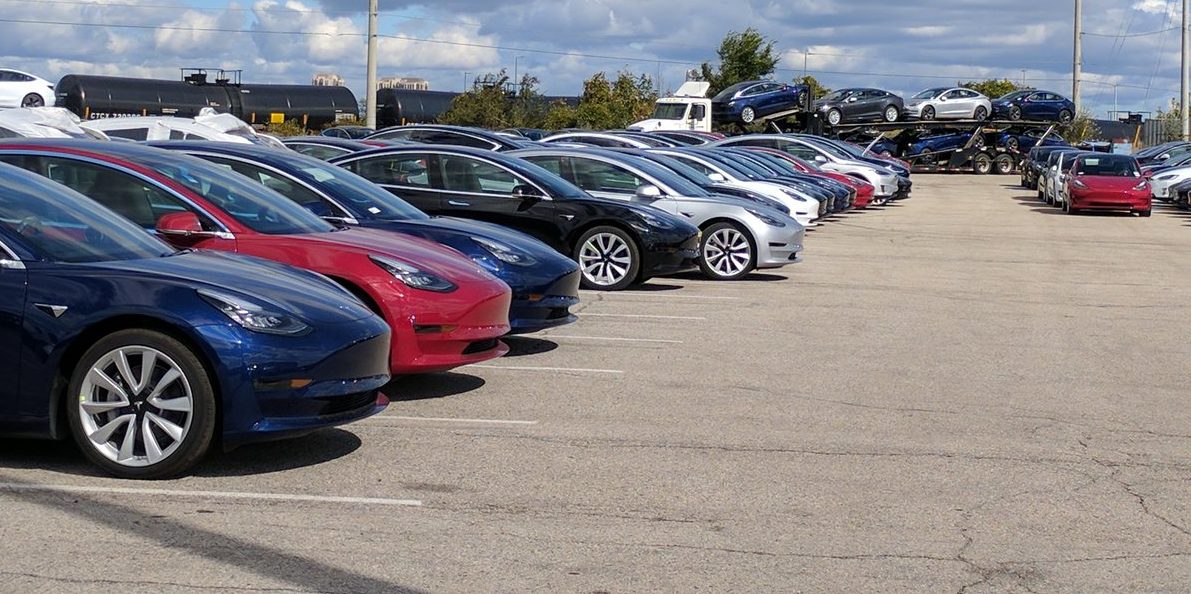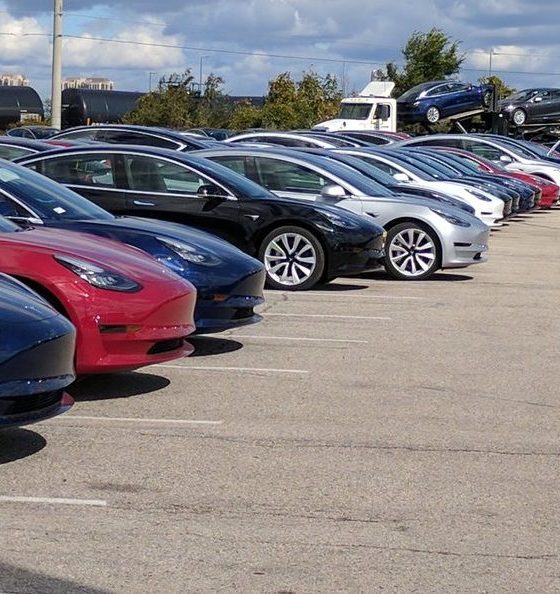

Investor's Corner
Elon Musk’s SEC settlement has cleared a path for Tesla’s record-breaking Q3 results
For Tesla, the past three months have been filled with incredible milestones and daunting challenges. Since producing 5,000 Model 3 in a week at the end of Q2, the electric car maker has steadily pushed itself out of “production hell” and well into Elon Musk’s self-dubbed “delivery logistics hell.” As the final hours of the third quarter trickle down, Tesla is now on full throttle as it attempts to end Q3 2018 on a historic note.
It has not been easy for Tesla, and particularly its CEO, Elon Musk. It is not difficult to see that Musk’s status as a rockstar CEO has served Tesla well, but at the same time, some of Musk’s personal mistakes have also negatively affected the electric car maker. Earlier this month, for example, Tesla stock took a steep tumble after news of two executive departures were augmented by Musk’s actions during a podcast, which included an instance when he seemingly smoked cannabis.
Perhaps Musk’s most notable gaffe, though, was a post last August stating that he was considering taking Tesla private at $420 per share, and that he had “funding secured.” The Securities and Exchange Commission (SEC) ultimately filed a lawsuit against Musk over his “funding secured” tweet, claiming that the CEO knowingly misled investors. Musk settled with the SEC this weekend, agreeing to pay a total penalty of $40 million, comprised of a $20 million personal fine and another $20 million fine for Tesla. Part of the settlement also included Musk’s resignation as Chairman of Tesla’s Board of Directors, the appointment of two new independent directors, as well as the creation of a new committee tasked to “place additional controls and procedures to oversee Musk’s communications,” particularly on social media platforms such as Twitter.
While it is unfortunate that Elon Musk must relinquish his post as Chairman of Tesla’s Board of Directors, his settlement with the SEC could ultimately be seen as Musk’s decision to take a personal blow instead of compromising Tesla’s progress. Elon Musk, after all, reportedly rejected the SEC’s initial settlement, and by Friday, it seemed like he was preparing to battle it out with the government agency. This was one of the reasons why the SEC’s announcement on Saturday about Elon Musk’s settlement came as a welcome surprise for the Tesla community.
Ultimately, Elon Musk appears to have put Tesla before his own wishes to fight back against the SEC. And it wasn’t like he was cornered by the government agency either. Former SEC senior counsel Thomas Gorman, who is also a partner at the law firm Dorsey & Whitney, stated that the agency miscalculated when it filed a lawsuit against Musk. Gorman noted that while Elon Musk’s “funding secured” tweet last August was not smart from a business perspective, the SEC would have a very difficult time proving that the CEO actually committed fraud. Gorman further noted that the Saudi fund’s reported interest in Tesla’s take-private deal would likely be enough to make Musk’s statements legal.
“There’s a reasonable basis for what he said. I’m not questioning their motive. I just disagree with their judgment here,” Gorman said.
Ultimately, Elon Musk’s SEC settlement has now provided a clear path for Tesla to attain a record-breaking third quarter without any unnecessary drama. Elon Musk himself has noted that Tesla’s main challenge now is delivering as many vehicles to reservation holders as quickly as possible. Tesla, for its part, has begun adapting to the delivery challenges. Handovers reportedly go well into the night, home deliveries are being done to a number of reservation holders, and even owners of Tesla vehicles who are willing to volunteer their time have been tapped to help the company in its end-of-quarter push. Tesla’s production and delivery figures this Q3 would likely set new records, and with Elon Musk’s SEC lawsuit in the rearview mirror, there is very little that can come between the electric car maker and even more impressive milestones.

Investor's Corner
Tesla stock closes at all-time high on heels of Robotaxi progress

Tesla stock (NASDAQ: TSLA) closed at an all-time high on Tuesday, jumping over 3 percent during the day and finishing at $489.88.
The price beats the previous record close, which was $479.86.
Shares have had a crazy year, dipping more than 40 percent from the start of the year. The stock then started to recover once again around late April, when its price started to climb back up from the low $200 level.
This week, Tesla started to climb toward its highest levels ever, as it was revealed on Sunday that the company was testing driverless Robotaxis in Austin. The spike in value pushed the company’s valuation to $1.63 trillion.
Tesla Robotaxi goes driverless as Musk confirms Safety Monitor removal testing
It is the seventh-most valuable company on the market currently, trailing Nvidia, Apple, Alphabet (Google), Microsoft, Amazon, and Meta.
Shares closed up $14.57 today, up over 3 percent.
The stock has gone through a lot this year, as previously mentioned. Shares tumbled in Q1 due to CEO Elon Musk’s involvement with the Department of Government Efficiency (DOGE), which pulled his attention away from his companies and left a major overhang on their valuations.
However, things started to rebound halfway through the year, and as the government started to phase out the $7,500 tax credit, demand spiked as consumers tried to take advantage of it.
Q3 deliveries were the highest in company history, and Tesla responded to the loss of the tax credit with the launch of the Model 3 and Model Y Standard.
Additionally, analysts have announced high expectations this week for the company on Wall Street as Robotaxi continues to be the focus. With autonomy within Tesla’s sights, things are moving in the direction of Robotaxi being a major catalyst for growth on the Street in the coming year.
Elon Musk
Tesla needs to come through on this one Robotaxi metric, analyst says
“We think the key focus from here will be how fast Tesla can scale driverless operations (including if Tesla’s approach to software/hardware allows it to scale significantly faster than competitors, as the company has argued), and on profitability.”

Tesla needs to come through on this one Robotaxi metric, Mark Delaney of Goldman Sachs says.
Tesla is in the process of rolling out its Robotaxi platform to areas outside of Austin and the California Bay Area. It has plans to launch in five additional cities, including Houston, Dallas, Miami, Las Vegas, and Phoenix.
However, the company’s expansion is not what the focus needs to be, according to Delaney. It’s the speed of deployment.
The analyst said:
“We think the key focus from here will be how fast Tesla can scale driverless operations (including if Tesla’s approach to software/hardware allows it to scale significantly faster than competitors, as the company has argued), and on profitability.”
Profitability will come as the Robotaxi fleet expands. Making that money will be dependent on when Tesla can initiate rides in more areas, giving more customers access to the program.
There are some additional things that the company needs to make happen ahead of the major Robotaxi expansion, one of those things is launching driverless rides in Austin, the first city in which it launched the program.
This week, Tesla started testing driverless Robotaxi rides in Austin, as two different Model Y units were spotted with no occupants, a huge step in the company’s plans for the ride-sharing platform.
Tesla Robotaxi goes driverless as Musk confirms Safety Monitor removal testing
CEO Elon Musk has been hoping to remove Safety Monitors from Robotaxis in Austin for several months, first mentioning the plan to have them out by the end of 2025 in September. He confirmed on Sunday that Tesla had officially removed vehicle occupants and started testing truly unsupervised rides.
Although Safety Monitors in Austin have been sitting in the passenger’s seat, they have still had the ability to override things in case of an emergency. After all, the ultimate goal was safety and avoiding any accidents or injuries.
Goldman Sachs reiterated its ‘Neutral’ rating and its $400 price target. Delaney said, “Tesla is making progress with its autonomous technology,” and recent developments make it evident that this is true.
Investor's Corner
Tesla gets bold Robotaxi prediction from Wall Street firm
Last week, Andrew Percoco took over Tesla analysis for Morgan Stanley from Adam Jonas, who covered the stock for years. Percoco seems to be less optimistic and bullish on Tesla shares, while still being fair and balanced in his analysis.

Tesla (NASDAQ: TSLA) received a bold Robotaxi prediction from Morgan Stanley, which anticipates a dramatic increase in the size of the company’s autonomous ride-hailing suite in the coming years.
Last week, Andrew Percoco took over Tesla analysis for Morgan Stanley from Adam Jonas, who covered the stock for years. Percoco seems to be less optimistic and bullish on Tesla shares, while still being fair and balanced in his analysis.
Percoco dug into the Robotaxi fleet and its expansion in the coming years in his latest note, released on Tuesday. The firm expects Tesla to increase the Robotaxi fleet size to 1,000 vehicles in 2026. However, that’s small-scale compared to what they expect from Tesla in a decade.
Tesla expands Robotaxi app access once again, this time on a global scale
By 2035, Morgan Stanley believes there will be one million Robotaxis on the road across multiple cities, a major jump and a considerable fleet size. We assume this means the fleet of vehicles Tesla will operate internally, and not including passenger-owned vehicles that could be added through software updates.
He also listed three specific catalysts that investors should pay attention to, as these will represent the company being on track to achieve its Robotaxi dreams:
- Opening Robotaxi to the public without a Safety Monitor. Timing is unclear, but it appears that Tesla is getting closer by the day.
- Improvement in safety metrics without the Safety Monitor. Tesla’s ability to improve its safety metrics as it scales miles driven without the Safety Monitor is imperative as it looks to scale in new states and cities in 2026.
- Cybercab start of production, targeted for April 2026. Tesla’s Cybercab is a purpose-built vehicle (no steering wheel or pedals, only two seats) that is expected to be produced through its state-of-the-art unboxed manufacturing process, offering further cost reductions and thus accelerating adoption over time.
Robotaxi stands to be one of Tesla’s most significant revenue contributors, especially as the company plans to continue expanding its ride-hailing service across the world in the coming years.
Its current deployment strategy is controlled and conservative to avoid any drastic and potentially program-ruining incidents.
So far, the program, which is active in Austin and the California Bay Area, has been widely successful.








